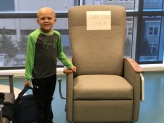RNA-ECS to Quantify Rare Clonal RNA Species at Diagnosis, Remission and Relapse from the COG AAML1031 Study

Background
Acute myeloid leukemia (AML) only accounts for 25% of pediatric leukemia cases but accounts for 50% of pediatric leukemia deaths. AML arises from and progresses due to a gradual accumulation of mutations that impact treatment efficacy and increase the risk of relapse. One reason for poor outcomes is the inability to precisely assess the genetic differences in the patient and their leukemia before and after treatment. More precise methods to detect AML cells and characterize the specific genetic differences in these cells will allow physicians to identify precision therapeutics rather than the toxic, non-specific therapies that are currently employed. Together, these strategies are sure to lead to better outcomes for children with AML. The Druley lab has developed an error-corrected sequencing method that improves the sensitivity of standard sequencing by 100-fold, which can detect residual leukemia cells. With this, the Druley lab is leading a study for the Children’s Oncology Group to apply this sequencing strategy to the largest study of pediatric AML completed to date. However, to improve the results that come from this major initiative, it is imperative to demonstrate which mutated genes exist in the same leukemia cell.
Project Goal
To achieve this, we will employ novel platforms for single-cell DNA and RNA sequencing from this unique collection of samples. We will survey three AML subtypes: infants, children and adolescents, and use artificial intelligence to aggregate these data with the existing demographic, clinical and outcome data available for each child.
Project Update - June 2020
For individuals who develop acute myeloid leukemia (AML), whether they are 2 years old or 92 years old, the first line of therapy was developed in 1973 and has not substantially improved. Outcomes remain poor compared to other leukemias and, while new, targeted therapies are being developed, standard disease surveillance tools often do not offer enough resolution of genes and mutations to identify relapsed disease and effectively treat it. This large international genetic analysis of children with AML will provide the largest, highest resolution dataset of gene mutations present before and after treatment to improve surveillance, treatment and ultimately, good outcomes for children with AML.

